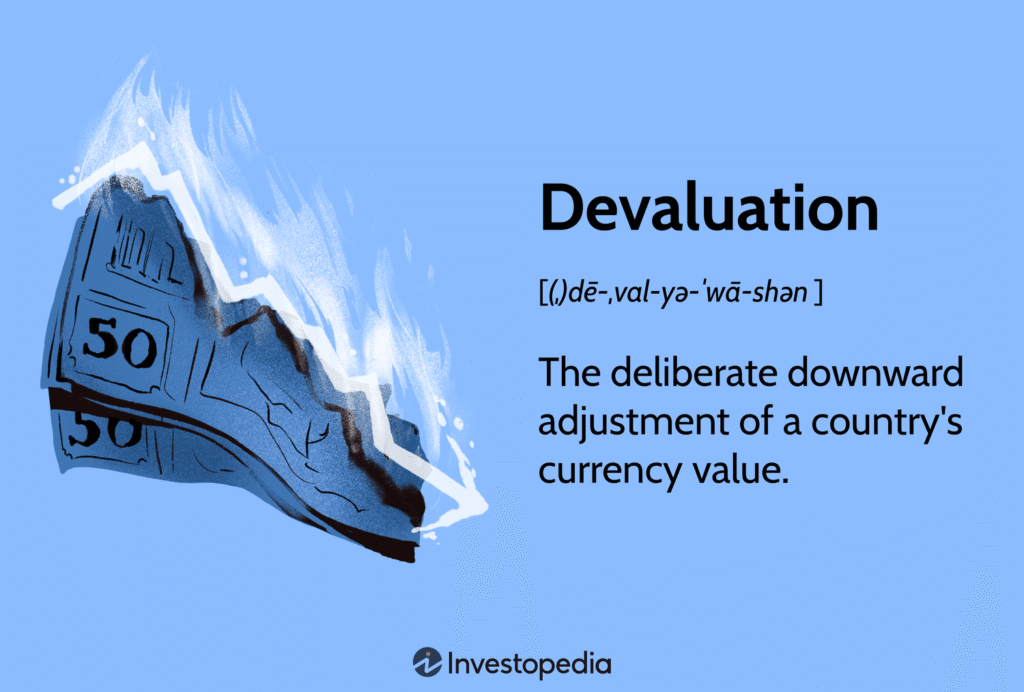What Is Devaluation?
Currency devaluation occurs when a government deliberately lowers the value of its national currency compared to other currencies, primarily under a fixed or semi-fixed exchange rate regime. This strategy can make a country’s exports more competitive and imports more expensive, aiming to correct trade imbalances and stimulate economic growth. However, while it can attract foreign investment and enhance export demand, devaluation may also lead to increased inflation and potential trade tensions.
Key Takeaways
- Devaluation is a deliberate reduction of a country’s currency value to make exports cheaper and imports more expensive.
- While currency devaluation can correct trade imbalances and attract foreign investment, it can also lead to inflation and trade tensions.
- Devaluation is distinct from depreciation, which occurs due to market forces in a floating exchange rate system.
- Historical conflicts, such as those involving China and the U.S., often revolve around currency devaluation as a trade strategy.
- Governments may use tariffs to counteract the effects of devaluation when imports become too cheap.
Investopedia / Lara Antal
Devaluation’s Impact on Global Trade and Domestic Economies
When a country devalues its currency, its exports become cheaper and more competitive globally. In contrast, foreign goods become pricier, reducing import demand. Governments devalue currencies to fix trade imbalances by increasing exports over imports.
More exports and fewer imports improve the balance of payments and reduce the trade deficit. Devaluation helps a country lower its deficit due to higher demand for cheaper exports.
Weighing the Benefits and Drawbacks of Currency Devaluation
Devaluing a currency can be an option, but it also has negative consequences.
- Higher import prices protect local industries, but without competition, they might become less efficient.
- Higher exports relative to imports can also increase aggregate demand, leading to inflation.
- Manufacturers may have less incentive to cut costs because exports are cheaper, increasing the cost of products and services over time.
Currency Wars: Examining Devaluation and Its Role in Global Tensions
There has been historical conflict between countries such as China and the United States over the valuation of their currencies. Devaluation keeps a country globally competitive and attracts foreign investment.
Important
In August 2023, Fitch Ratings downgraded the United States’ Long-Term Foreign-Currency Issuer Default Rating (IDR) to “AA+” from “AAA.” The downgrade reflects the expected fiscal deterioration over the next three years, a high and growing general government debt burden, and the erosion of governance relative to “AA” and “AAA” peers over the last two decades resulting in repeated debt limit standoffs and untimely resolutions.
The 1988 Omnibus Trade Act mandates that the U.S. Treasury check if other countries manipulate their currency’s exchange rate against the U.S. dollar. In 2019, Secretary Mnuchin reported that China devalued its currency to gain an unfair trade advantage.
In 2025, after trade issues from U.S. tariffs, China’s central bank began to slowly weaken the yuan in order to keep the export-led economy competitive. The offshore yuan fell to 7.43 per dollar in April 2025, although analysts predicted that the Chinese government would avoid sharper devaluations to preserve market stability.
What Is the Role of Tariffs in Counteracting Devaluation?
If imports become too cheap, a country might use tariffs to boost their prices, encouraging demand for local products.
What Is the Impact of Currency Devaluation on International Trade?
Devaluation shifts international trade, favoring the devaluing country. It alters currency values and the cost of goods between countries.
What Is the Difference Between Devaluation and Depreciation?
Devaluation occurs when a government changes the fixed exchange rate of its currency. Most currencies traded on foreign exchange markets are not pegged to another currency, and the market determines their value with floating exchange rates. If the demand for one currency changes relative to another due to market forces and loses value, it is called depreciation.
Key Insights on Currency Devaluation’s Trade Effects
Currency devaluation is a deliberate policy tool used by governments to lower the value of their currency, primarily to enhance export competitiveness and reduce trade imbalances. By making exports cheaper on the global market and imports more expensive, devaluation can effectively shrink a trade deficit, bolstering a country’s economy.
However, it also carries potential downsides, such as triggering inflation and reducing the incentive for domestic industries to improve efficiency. Understanding both the benefits and drawbacks of devaluation is crucial for governments and investors grappling with global trade dynamics.







